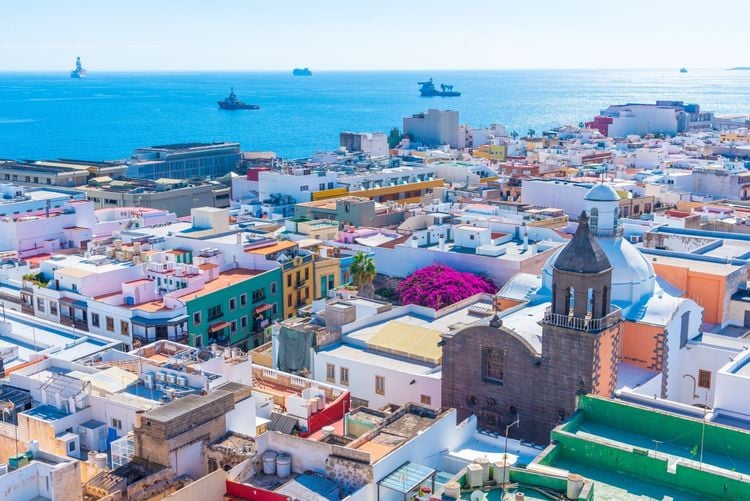The district of Vegueta is the old part of Las Palmas de Gran Canaria. Located in the south of the city, it represents the foundational nucleus of the capital since the end of the 15th century. As you walk around this area of Las Palmas, you will notice that most of the streets are pedestrianised, so it is best to visit it on foot. Late Gothic and Renaissance in style, the streets winding through the picturesque corners of the city will take you to some of Gran Canaria's most emblematic sites. Highlights include the cathedral of Santa Ana, seat of the Catholic Church's Diocese of the Canary Islands, and the square that bears its name.
Located in the northeast of the island, Las Palmas de Gran Canaria, capital of this "miniature continent", offers sun, beaches and mild temperatures. As soon as you arrive at Gran Canaria airport you feel enveloped by the subtropical climate. Already in the capital of Gran Canaria you can see in the distance Playa de Las Canteras, one of the best beaches on the island. Within Las Palmas, it's worth taking a stroll around the Plaza de Santa Ana and the cathedral of the same name, strolling through the historic district of Vegueta, and learning even more about the culture of Gran Canaria by visiting the Casa de Colón, another iconic building of Las Palmas. There are plenty of activities to do here, both cultural and leisure. If you have the chance to be in the capital of this island at the end of February you will have the opportunity to see the Las Palmas de Gran Canaria carnival celebration.
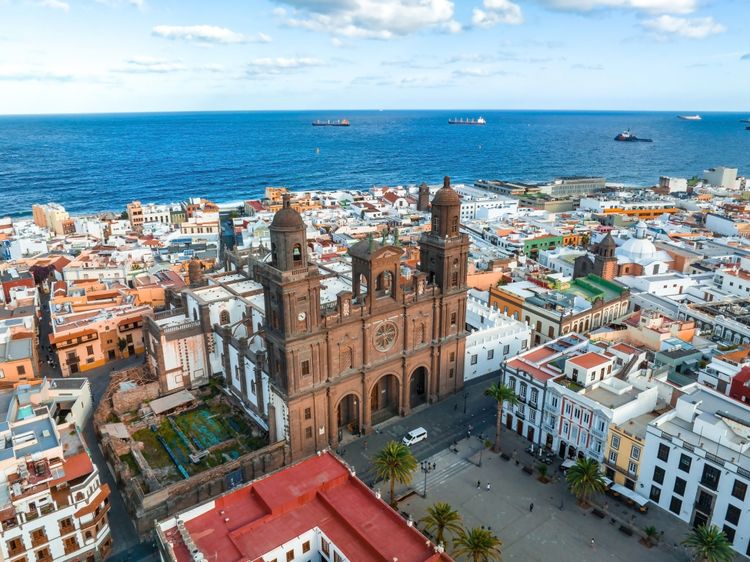
Landscape with Santa Ana Cathedral in Las Palmas de Gran Canaria.
- © Pandora Pictures / Shutterstock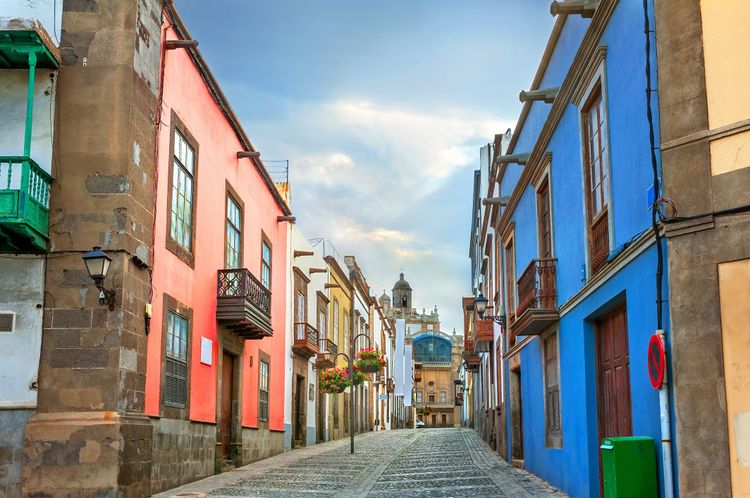
Small cobblestone pedestrian street with colorful facades of houses in the old neighborhood of Vegueta.
- © Valery Bareta / ShutterstockA few steps from the cathedral, nestled in the historic quarter, is the Casa de Colón. This 500-year-old building is one of the most unique buildings in Las Palmas and houses a museum about the history of the city and the influence Christopher Columbus had on the Canary Islands. A few steps away is El Deseo, a very good restaurant where you can try typical Canarian food.
To get into the heart of Las Palmas you must go to the bustling Vegueta market, the oldest in the city, where you will find a wide variety of typical products of the island. In addition to these places, the wide range of shops in the old part of the city extends along the shopping street of Triana.

Triana Street, full of charm.
- © Canary4stock / ShutterstockTriana, the shopping area
Across the Guiniguada ravine is one of the most important open shopping areas in Las Palmas de Gran Canaria. The Triana neighbourhood, which grew out of the expansion of the historic district of Vegueta at the end of the 15th century, now has the most emblematic street in the city, full of family-run shops and franchises, emblematic buildings and very unique houses.
As you cross the avenue you'll discover plenty of hidden spots worth the detour, such as the Parque de San Telmo along with its hermitage, the Palacete Rodríguez Quegles on Calle de San Bernardo, the Pérez Galdós theatre and the Gabinete Literario in the Plaza de la Alameda de Colón. This picturesque street holds within itself the history of this island capital; the rails of "La Pepa", the tram that once ran along this lively street, still remain.
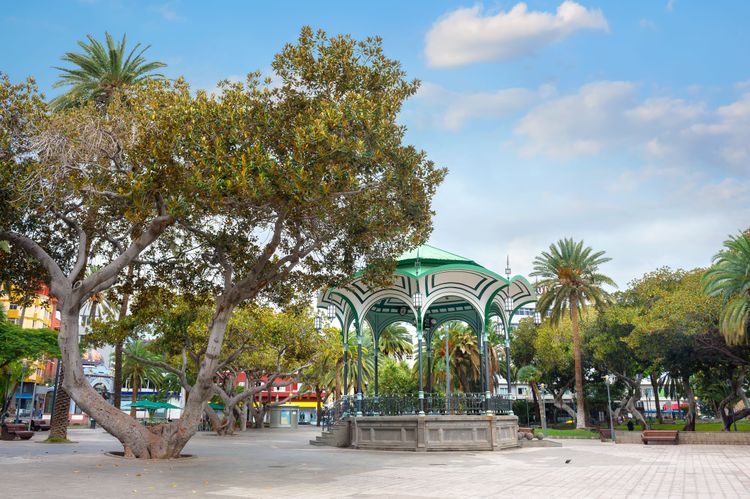
Kiosk in San Telmo Park.
- © Valery Bareta / ShutterstockThe seaside neighbourhood of San Cristóbal
Known for its duty-free shopping areas, Las Palmas de Gran Canaria is also an important cruise port in the Canaries, as it has a strategic location and openness to the sea. Among its many neighbourhoods, one that is little known is the seafaring neighbourhood of San Cristobal, a small fishing village with a wide variety of restaurants where you can eat fresh fish and Canarian food, such as the Miramar San Cristobal Restaurant.
Located in the capital of Gran Canaria, San Cristóbal is a nucleus of more or less uniform houses near the sea, with an avenue and promenade, as well as a small port dating from 1980. It is also where Chinchorro, a traditional and previously forbidden form of fishing, was started.
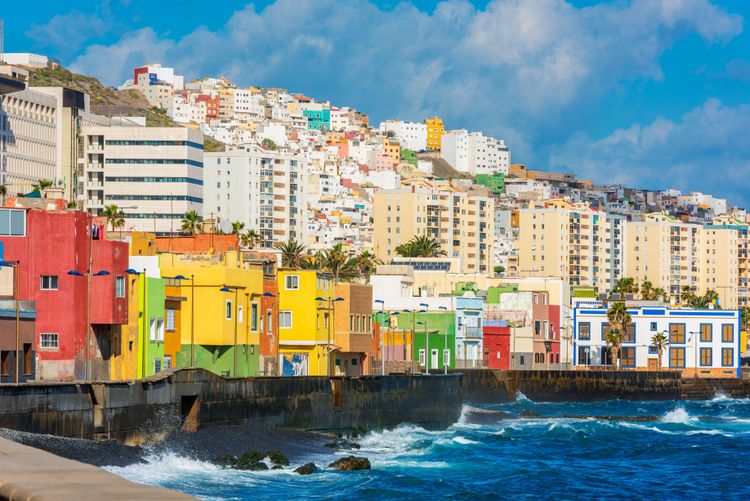
Colorful houses in San Cristobal, a coastal town and suburb of the capital Las Palmas in Gran Canaria.
- © Allard One / ShutterstockThe seaside district of San Cristóbal is also home to the Torreón de San Pedro Mártir, popularly known as the Castle of San Cristóbal. This ancient fortress served as a watchtower and defence point for Las Palmas, and was declared a historic-artistic monument in 1922. Today, the seaside neighbourhood, nestled in the cosmopolitan city of Las Palmas but far from the centre, is the ideal place to enjoy the beauty of the island of Gran Canaria.
Our favourite hotel
"An emblematic house for a unique experience in Vegueta. The heart of the Foundational City of Las Palmas de Gran Canaria".
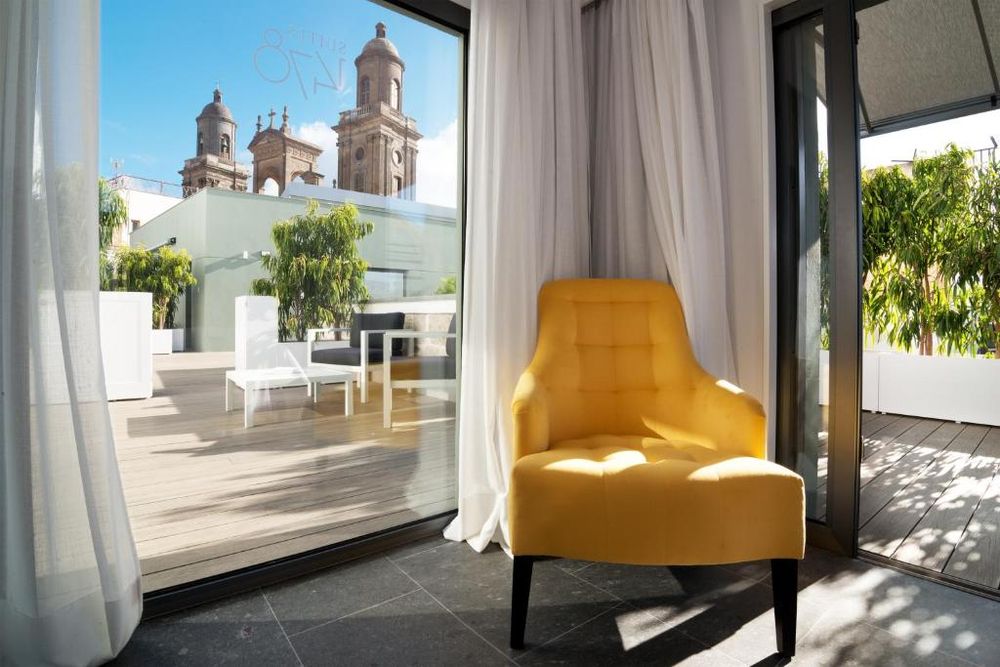 Gran Canaria
Gran Canaria
Suites 1478
Beautiful suites in Vagueta, overlooking the cathedral.How to get to Las Palmas de Gran Canaria from LPA airport?
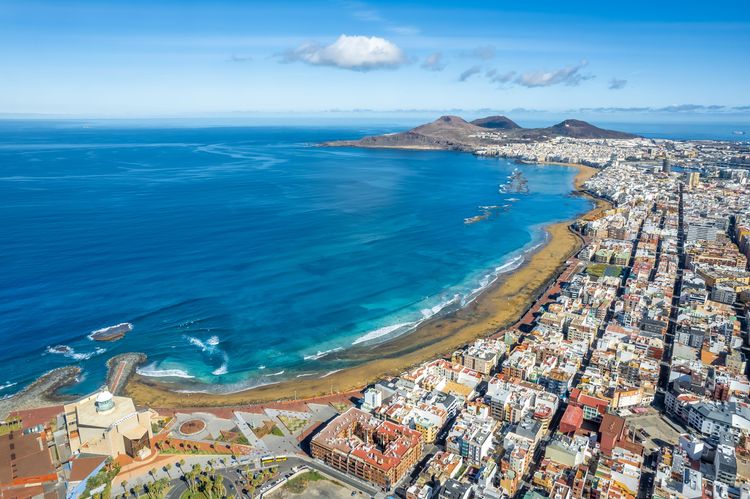
Panoramic view of Las Palmas.
- © Serenity-H / ShutterstockGran Canaria Airport (LPA) is located on the east coast, south of Las Palmas de Gran Canaria and Telde, parallel to the GC-1 motorway. If you want to get from the airport to Las Palmas you can rent a car at the airport and drive straight north along the GC-1. It is 21 kilometres, which takes about 20 minutes to reach the city.
Alternatively, you can opt for public transport and take the Global bus number 60, which takes you twice an hour to and from Las Palmas de Gran Canaria. You'll have two stops to get off at to visit Las Palmas: San Telmo and Santa Catalina. It takes 30 minutes from the airport to San Telmo station and 45 minutes to the Santa Catalina interchange. As the journey to San Telmo is shorter, the ticket costs €2.30, while the ticket to Santa Catalina costs €2.95.
The last option is the taxi. This costs around €30 one way to the Vegueta and Triana areas of Las Palmas, and €35 if you want to go to the north of the city around Las Canteras beach.
A few tips
- If you want to visit the neighbourhoods of Vegueta and Triana first, we recommend you get off at the Santa Catalina stop. If you prefer to go through the neighbourhood of San Cristóbal, we recommend you get off at the San Telmo stop, as it is closer.
- Although Gran Canaria does have public transport, it is highly recommended that you hire a car as many of the island's most interesting and outstanding sites are only accessible by public transport.
- As big as the city of Las Palmas de Gran Canaria is, it is ideal to stay there for at least 2 or 3 days so that you don't miss anything, and also so that you don't go in a hurry.
